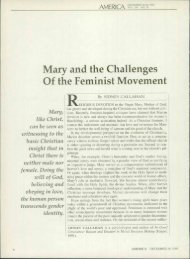You also want an ePaper? Increase the reach of your titles
YUMPU automatically turns print PDFs into web optimized ePapers that Google loves.
Often teachers do not even know that they are teaching<br />
conative skills. One day I ate lunch with two Catholic Relief<br />
Service staffers who had just finished a workshop on leadership<br />
styles. They reported to me how they had characterized<br />
various personalities in the field of social ministry, and to my<br />
surprise one said, “Then there is Drew Christiansen: ‘casual<br />
relentlessness.’” I hardly knew Kate Moynihan; I had met her<br />
only once before in a hurried meeting when I was escorting a<br />
bevy of bishops in war-torn Croatia, but she had studied my<br />
working style from afar. Casual relentlessness—that’s how I<br />
work. Not with a lot of fuss, but steadily, thoroughly, doggedly.<br />
It has made a difference.<br />
To illustrate education for struggle, perseverance and sacrifice,<br />
I will use a few examples from my own teaching. For<br />
a doctoral seminar on equality, I assigned Richard Kluger’s<br />
Simple Justice, a history of the fight against segregation from<br />
Plessy v. Ferguson to Brown v. Board of Education. I would<br />
allow students two weeks without class to read the enormous<br />
book, but it was always a success. The students got<br />
the point of the long and many-sided effort necessary to<br />
achieve racial justice.<br />
Teaching undergraduates about nonviolence, I assigned<br />
Phillip Gallie’s Lest Innocent Blood Be Shed, the story of the<br />
nonviolent witness of the Huguenot pastor Andre Trocmé<br />
and the townspeople of Chambon sur Lignon, France, who<br />
during World War II provided some 500 Jews asylum right<br />
under the eyes of German troops. Then we would view the<br />
film “Weapons of the Spirit,” based on Gallie’s book. We<br />
discussed the feasibility of nonviolence, as well as the spiritual<br />
qualities and practical stratagems necessary to make<br />
nonviolent resistance effective. Richard Attenborough’s film<br />
“Gandhi” fascinated even the most skeptical students, convincing<br />
them of the practicality of nonviolence.<br />
An important reason for cultivation of the will is that we<br />
can easily become satisfied with a low level of goodness,<br />
what the philosopher Alfred North Whitehead called “anesthesia.”<br />
From anesthesia it is only a short step to atrocity, for<br />
we have ceased to see the big moral choices before us. To<br />
illustrate how complacency with conventional goodness<br />
dulled the capacities for moral action, I used to assign<br />
undergraduates Langdon Gilkey’s memoir Shantung<br />
Compound, moral tales drawn from his internment in a<br />
Japanese prisoner of war camp in China during World War<br />
II. The moral contrast, Gilkey found, was between the<br />
majority of interned Christian missionaries, whose conventional<br />
morality prevented them from extending themselves<br />
to new inmates, and the prostitutes, monks and nuns who<br />
in very straitened circumstances found ways to share limited<br />
resources with newcomers.<br />
Finally, education for justice requires freeing the imagination<br />
and stimulating inventiveness. What often inhibits<br />
people from taking moral responsibility is the thought that<br />
the practice of nonviolent resistance is impossible. A lack of<br />
feasibility and the size of the obstacles become excuses for<br />
not rousing oneself to action or for avoiding difficulty; but<br />
inhibition may also stem from a failure of moral imagination<br />
to see possibilities. History, biography and drama can<br />
free the imagination to visualize opportunities for doing<br />
good and for resisting evil. Role-playing, drafting model<br />
programs for action and sketching campaigns for social<br />
change, which bring the imagination into play, can help students<br />
visualize the practical steps that can be taken.<br />
Organizational Skills<br />
I harbor some suspicion of the solitary-prophet model of<br />
doing justice and making peace. The church does posthumously<br />
recognize heroic peacemakers like Franz Jägerstätter<br />
and, I would hope, one day Gordon Zahn. But by and large,<br />
the people who effect change are not singular prophets;<br />
rather they are leaders of movements and builders of institutions.<br />
Even Gordon Zahn, who was for many years a<br />
lonely voice and who suffered for his convictions at the<br />
hands of both church and state, helped organize Pax Christi<br />
USA and contributed to the acceptance of nonviolent witness<br />
by the Second Vatican Council.<br />
Movements. Movements are the dynamic phase of any<br />
social change. Marvin Mich has shown how Catholic social<br />
teaching closely interacts with social movements.<br />
Movements generate ideas and transmit them. Movements<br />
possess a transformative power in relationships, first on<br />
their own followers and then on the wider society. Think of<br />
the influence that Dorothy Day and the Catholic Worker<br />
Movement or Jean Vanier and L’Arche have had on the<br />
social witness of our church and society.<br />
For young people, the appeal of social movements is<br />
many-sided: they challenge the status quo and conventional<br />
thinking; they provide opportunity for new relationships<br />
and for the excitement of collective action in protests and<br />
rallies, in what Charles Taylor describes as a distinctive<br />
form of postmodern religiosity that he calls festivity.<br />
Movements call for sacrifice and discipline, what William<br />
James called “the moral equivalent of war,” and with it the<br />
development of alternative markers of identity, so attractive<br />
to the young today.<br />
While the classroom is not a place to recruit for movements,<br />
the study of Catholic social teaching alongside the<br />
movements and personalities that have contributed to it and<br />
carried it can bring the bare ideas to life. In classrooms students<br />
can become acquainted with movements and local<br />
social justice organizations.<br />
Institutions. Sociologists claim it takes seven years for a<br />
charismatic movement to become an institution. Sometimes<br />
we speak disparagingly of “the routinization of charisma.”<br />
We might instead speak of the success of a movement as it<br />
12 <strong>America</strong> May 11, 2009









